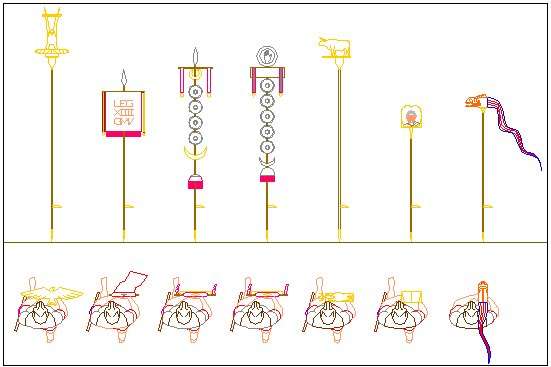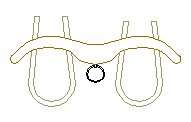Equipment
Sections
Standards
 Some of the types of standards used by the Roman army are shown in this illustration. The top part of the illustration shows the standards in profile, below each is an overhead view of the standard-bearer as he appears in the illustrations. From left to right the standards are: aquila, vexilla, three signa, imago and draco. A description of each follows.
Some of the types of standards used by the Roman army are shown in this illustration. The top part of the illustration shows the standards in profile, below each is an overhead view of the standard-bearer as he appears in the illustrations. From left to right the standards are: aquila, vexilla, three signa, imago and draco. A description of each follows.
Aquila: the eagle. After Marius, the Eagle was the symbol of the legion, its most prized standard. It was placed in the care of the Primus Pilus, the first centurion of the first century of the first cohort, the senior centurion in the legion. The soldier carrying it was called an aquilifer; the plural form is aquiliferi.
Vexilla: a small banner on a pole which carried the name of the legion or of detached units. Cavalry units were accompanied by a vexilla. The soldier was called a vexillarius; vexillarii, plural.
Signum: each century had its own standard called a signum. There were two variations, one with a spear point at the top of the pole, one with an open hand. The circular disks probably identified the century and the cohort to which it belonged. The soldier was a signifer; signiferi, plural.
Signum: I do not know of a proper name for this standard so have called it by the generic name, signum. Before Marius made the eagle the universal standard for the legions different legions had different animal figures as their standards. In this case I have represented the standard as a bull. It seems that at least some later legions also carried animal figures in addition to the eagle.
Imago: in imperial times the legions carried a small bust of the emperor. There was one per legion, the location of the imaginifer in the legion formation is not given. I have placed him with the legate and other officers. The soldier is the imaginifer or imaginiferi, plural.
Draco: late in the empire a new standard called the draco was adopted by the armies. The standard consisted of a dragon head with a cloth body that whipped in the wind. Some reports indicate that the draco made an eerie sound when the wind blew through it. The soldier carrying it was called a draconarius; draconarii, plural. Both foot and cavalry had the draco as one of their standards.
Wagons and transport
 Ancient means of land transport were seriously hampered by two factors. One was that the large draft horses we know had not been bred yet. The other, and more important factor, was that the horse harness had not been invented. The only way to yoke animals to wagons was the system that was developed for oxen. A simple yoke is illustrated on the right. It consists of a bar over the neck, hoops around the neck and an iron loop that the tongue of the wagon goes through. The elaborate harnesses used with draft horses today were unknown. The simple yoke works well with oxen because they have a hump against which the yoke can ride and because they carry their heads low.
Ancient means of land transport were seriously hampered by two factors. One was that the large draft horses we know had not been bred yet. The other, and more important factor, was that the horse harness had not been invented. The only way to yoke animals to wagons was the system that was developed for oxen. A simple yoke is illustrated on the right. It consists of a bar over the neck, hoops around the neck and an iron loop that the tongue of the wagon goes through. The elaborate harnesses used with draft horses today were unknown. The simple yoke works well with oxen because they have a hump against which the yoke can ride and because they carry their heads low.
Horses, carrying their heads up, are choked by the hoops when trying to pull a heavy load. Horses could effectively be used only for light loads. In practice, horses were used to pull light two wheeled carts and could make very good time doing so. But all heavy wagons were pulled by oxen.
Oxen have several advantages over horses. Since they chew a cud, they require less time eating. They can live on lower quality food. They can pull a great weight. But they have one big disadvantage. Their average speed is only about 1 mile per hour, whereas men and horses can easily walk 3 or even 4 miles per hour. There seem to have been several other difficulties with wagon transport. It does not seem that the ancients used grease to lubricate moving parts, making wagon axels not only noisy but more subject to friction. It is hotly debated but there is no clear evidence that ancient wagons had steerable front wheels, limiting their mobility. Roman roads were superb, but new territiories that the army would have crossed in its campaigns would not have had good roads.
For these reasons the preferred method of transport was by pack animals -- donkeys, horses or mules. They were faster than ox wagons and not as dependent on good road conditions. The preferred pack animal was the mule because it was generally larger than the donkey and had advantages over horses. The advantages of the mule over the horse are described in the Supplemental Information page for the march.
